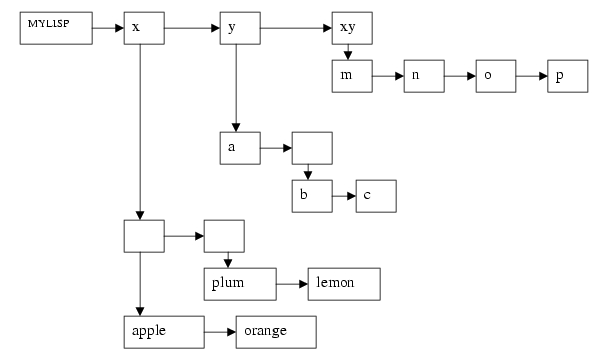
Notice that atomic elements are placed directly into the node, while a list is defined as an empty node which points to the sublist. In order to store the lists we can use the LISP command setq. For example:
This assignment will exercise your knowledge of 1P03 material. It is not a difficult assignment, but may be a little tedious.
LISP is a Language used for list processing and is often associated and used in the artificial intelligence community to implement AI type problems. Mainly LISP is a symbolic processing language which manipulates symbols as opposed to traditional languages like JAVA which manipulates objects. LISP is an acronym for LISt Processing but often this acronym is associated with Lost In Stupid Parenthesis (this will become apparent). The list in LISP is the corner stone in which statements are defined. A list is a sequence of items or elements enclosed in a pair of parentheses. Where each element can either be an atomic element (meaning a basic element) or another list. For example:
(a) -- single element a
(a b c) -- 1 list with a b c as elements.
(a (b c)) -- 1 list 2 elements where the second element is a list.
((apple orange) (plum lemon)) -- 1 list with 2 sublists, the
first apple orange the second plum lemon.
We can define variables associated with each list. So like any language we can declare x to represent say ((apple orange) (plum lemon)), thus if we refer to x we refer to ((apple orange) (plum lemon)). We will create a data structure which will be able to store LISP lists. Thi(s data structure will consist of a linked list of linked lists. The main section of the data structure will contain 1 link for each variable defined. For example:
x = ((apple orange) (plum lemon))
y = (a (b c))
xy=(m n o p)
Then the data structure would look as follows.

Notice that atomic elements are placed directly into the node,
while a list is defined as an empty node which points to the
sublist. In order to store the lists we can use the LISP command
setq. For example:
setq x '((apple orange) (plum lemon))
Note that the ' (apostrophe) is needed to indicate that ((apple orange) (plum lemon)) is literal. You will need to code this command to accept a literal or other variables. For example:
setq xy y --would make a copy of what y
represents and assign it to xy if y exists,
otherwise nothing happens. If xy does not exist it is created,
otherwise the new assignment supper-seeds the old.
setq x nil --would delete x from the data structure.
The command line version is used since this is traditionally the
way LISP interpreters worked, from the command line.
Now we need to be able to print the contents of a variable. Here we will use a command print n. Where n represents the variable to be printed if it exists. If n is omitted then all variables declared are printed. For Example:
print x
==> ((apple orange) (plum lemon))
--Prints
the value of x
print abc
==> NIL --Prints NIL since
the variable abc does not exist
print
==> ((apple orange) (plum lemon))
==> (a (b c))
==> (m n o p)
If you want to play a bit with lisp here is an online lisp
interpreter, http://rextester.com/l/common_lisp_online_compiler,
you can copy and paste the following into the "Lisp Input"
(setq a '(b c d))
(print a)
then hit evaluate